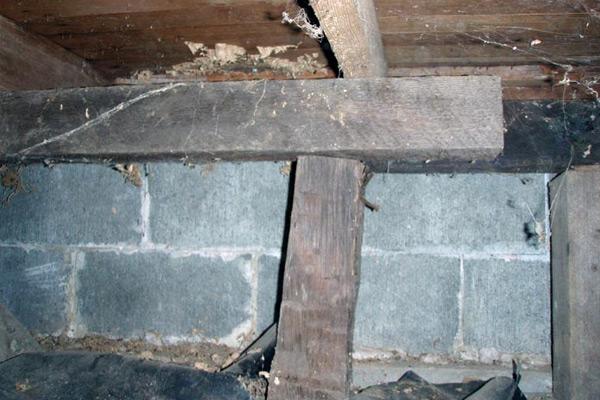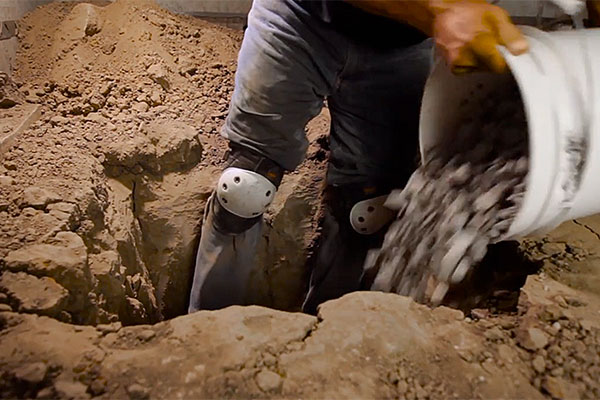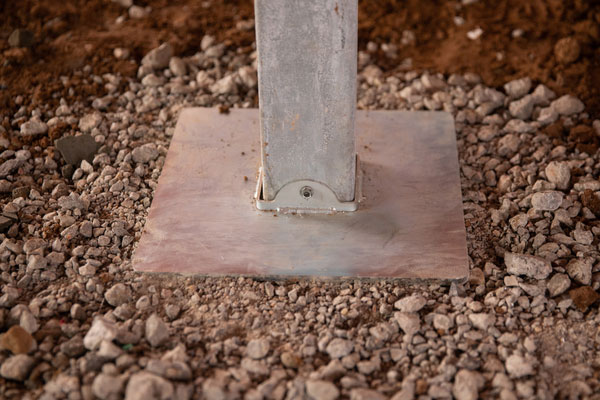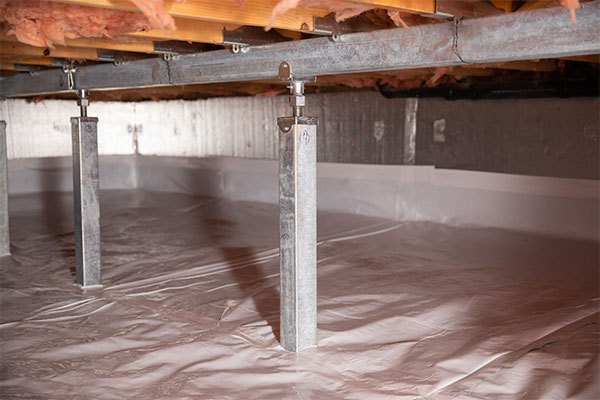Sagging Crawl Space Repair in Omaha, Kansas City, Wichita, & Nearby
We Fix Damaged & Sinking Crawl Spaces in Nebraska, Iowa, Missouri, Kansas, Illinois and Colorado
If you have noticed uneven floors, cracks in interior drywall, or window and door frames that aren't level, you may have a sagging crawl space. Your crawl space is out of sight, so it is no wonder that it is out of mind. However, issues with your crawl space could indicate a foundation problem. Even worse, crawl space problems can negatively impact your entire home.
A sinking crawl space doesn't just lead to uneven floors. Sagging crawl spaces can also result in moist, rotting wood and skewed door frames. It makes sense that homeowners often overlook a damaged crawl space, but there are a couple of telltale signs that your crawl space is sinking or otherwise damaged:
Signs that you have a sagging crawl space in Nebraska, Iowa, Missouri, Kansas, Illinois and Colorado
- Sloping, sinking, or uneven floors upstairs
- Skewed or unlevel door & window frames
- Cracks in interior drywall
- Tilting crawl space supports
- Moist, rotting wood
- Too few supports in the crawl space
Schedule a free crawl space repair estimate to learn more. We proudly serve Nebraska, Iowa, Missouri, Kansas, Illinois and Colorado areas throughout Kansas City, Denver, Omaha, and nearby.
Causes of Crawl Space Damage
Though insufficient support posts are a common cause of sinking crawl spaces, there are a number of reasons your crawl space might be damaged, including weakening crawl space posts from moisture.

Support Posts Spaced Too Far Apart
When crawl spaces are built, columns are placed throughout the crawl space to support the weight of the home above. If these columns are spaced too far apart from each other, the girders and beams may be overloaded with weight, causing them to sag between the columns.

Rot-Weakened Floor Joists/Girders
Frequently, crawl spaces are not sealed from the earth around them and are left vulnerable to humidity and moisture. This moisture creates an environment in which mold and rot can thrive, damaging the wood structure of the home. Weakened by the moisture, floor joists and girders are unable to support the weight of the home.

Settling Columns Due to Weak Soil
Too often, crawl space support posts are installed on soils that are not solid enough to support the weight of the home. Weak supporting soils allow your crawl space columns to settle or sink, creating a gap between the top of the column and the bottom of the girder it supports. Once the column has settled, the girder above will begin to sag.
Prevent Damage With Durable Crawl Space Repairs
Thrasher Foundation Repair knows the importance of a healthy, functional crawl space. If the floors over your crawl space are sagging, house jacks might be the answer to re-level your sagging crawl space. Our skilled specialists can install the SmartJack® Crawl Space Support System to help you eliminate structural problems with your crawl space.
With the support of structural engineers, Thrasher Foundation Repair's team of crawl space repair experts can provide you with an effective, long-lasting solution to keep your crawl space strong and your floors level for the long haul.

SmartJack® installed to repair sagging crawl space.
Features & Benefits of The SmartJack®
- Can be installed in tight conditions
- Installation typically takes less than a day
- Galvanized steel resists corrosion
- Supports loads of more than 60,000 lbs
- Addresses soil problems
- Installation won't disturb the home or landscaping
SmartJack® Installation
The SmartJack® installation is a quick process that won't impact your home or the surrounding landscape. Your trusted installers will complete the following steps:

1. Preparing for Installation
Before the installation, one of our specialists will meet with you to create a crawl space support system providing long-term structural stability. During this visit, they will explain the process and answer any questions you may have about your crawl space repair.
Next, our installers determine the location for each crawl space support - this ensures an efficient, seamless installation of your crawl space support system.
Once the installation begins, our in-house crawl space repair contractors will clear out a 2' square, 2' deep hole at each SmartJack® location.

2. Placing the Footings
Our experts will place a base, also known as a footing, on top of the engineered fill, carefully leveling it. This footing provides a stable base for the steel jack post and keeps the post vertical, allowing for better weight-bearing distribution across a wide area of soil. The fill base underneath the footing offers strong support that resists moisture and won't settle or shift.

3. Cutting the Jack Posts to Length
Once we install the new bases, we take measurements for the steel crawl space jack posts and then cut them to length.
The steel tubes in each SmartJack® come equipped with a three-layer, in-line galvanized coating. This coating includes:
- A hot-dip galvanizing layer
- An intermediate conversion coating to enhance corrosion resistance
- A clear, organic top coating to increase strength and boost appearance
- A zinc-rich coating on the inside of the pier tube
Once we install the SmartJack® in your crawl space, you can have peace of mind knowing you've invested in an industry-leading, permanent solution for your sagging crawl space.

4. Assembling & Tightening
We construct each crawl space post in your crawl space, then mount the top of the crawl space jack against the girder, and after, we carefully plumb the installation.
If you have damaged girders affected by rot or if girders are too small, we install a new sister girder next to the original to reinforce and strengthen the structure.
Then, in an attempt to lift the floor back to its original position, each SmartJack® is tightened. In many cases, our trusted contractors will be able to level floors, prevent future downward movement, and close cracks in walls. The jacks will continue to be adjustable for future tightening if needed.

5. Crawl Space Encapsulation
Addressing mold, rot, and moisture issues with your crawl space joists, girders, and supports is critical in preventing future crawl space damage.
Crawl space encapsulation prevents moisture-related damage and structural issues from rotting and deteriorating framing. When you invest in crawl space encapsulation, you'll also enhance your home's indoor air quality and energy efficiency.
The encapsulation process includes the installation of an airtight crawl space door, sealing all crawl space vents, a vapor barrier to crawl space walls and floors with a strong plastic liner. Additional drainage measures, such as interior drains or sump pumps, can also be taken.
Crawl Space Structural Support Experts Serving Nebraska, Iowa, Missouri, Kansas, Illinois and Colorado
For over 45 years, Thrasher Foundation Repair has set higher standards for the home improvement and repair industry. That's why we are the #1 choice for foundation repair services in Nebraska, Iowa, Missouri, Kansas, Illinois and Colorado. Our experts are more than prepared to take on your sagging crawl space.
Are you looking for a reliable solution for your crawl space problem? Our foundation repair professionals can help you restore your crawl space with minimal downtime. We provide free crawl space structural repair quotes to homeowners in Kansas City, Omaha, Wichita, Springfield, Denver, Des Moines, Sioux City, Peoria, Fort Madison, Grand Island, and the surrounding areas. Contact us today to schedule yours!
Get a Free Estimate

We serve the following areas
- Allenspark
- Bailey
- Black Hawk
- Breckenridge
- Cascade
- Central City
- Colorado Springs
- Como
- Conifer
- Cripple Creek
- Dillon
- Divide
- Dumont
- Eldorado Springs
- Empire
- Evergreen
- Fairplay
- Florissant
- Fountain
- Frisco
- Georgetown
- Golden
- Grant
- Green Mountain Falls
- Guffey
- Hartsel
- Idaho Springs
- Idledale
- Indian Hills
- Jamestown
- Jefferson
- Kittredge
- Lake George
- Littleton
- Louviers
- Manitou Springs
- Monument
- Morrison
- Nederland
- Palmer Lake
- Pine
- Pinecliffe
- Sedalia
- Shawnee
- Silver Plume
- Silverthorne
- Usaf Academy
- Victor
- Ward
- Woodland Park
